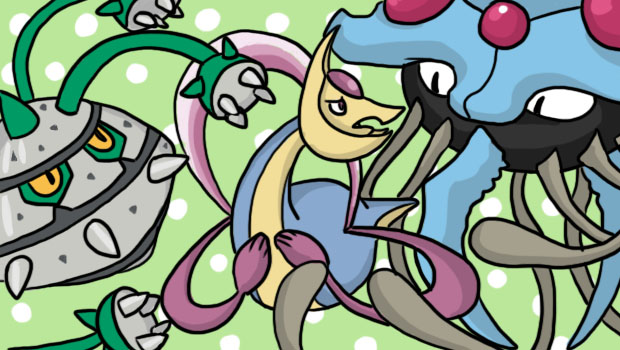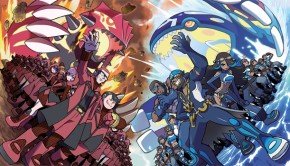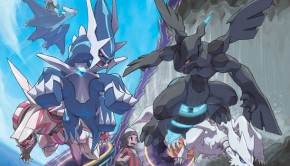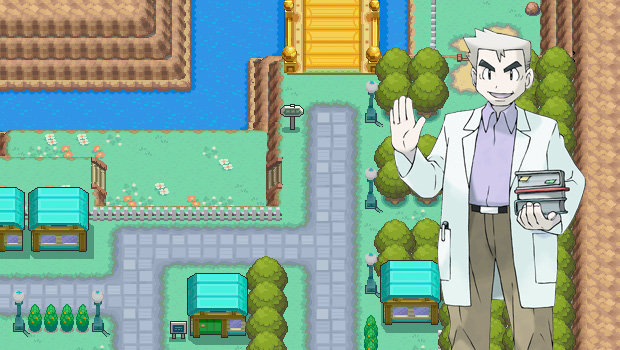Wi-Fi Tournament Team Building Guide / Tentacruel Enthusiast Report
Article image created by feathers for Nugget Bridge. View more of her artwork on her tumblr or Nugget Bridge forums thread.
I think normally when people write articles including their team it is because they think what they did was very good or creative. Today I present you with a team that is neither of those things: it is not particularly interesting, and, let’s face it, it is pretty terrible against players who actually know what they are doing. The beauty of this is that I still got a rating of 1912 in the Wi-Fi tournament with it, which was enough for 8 CP because my router mostly functions as intended. While there probably won’t be too much here for the super high end players, I think there’s probably some lessons I can pass on for players who didn’t do as well as they hoped to for reasons other than ragequitting Wi-Fi. My team was pretty poor, outside of a stretch on Saturday afternoon I wasn’t even playing particularly well, but I still wound up with a pretty acceptable result because I set myself up with a team that could compensate for my own frequent bouts of stupidity while being fairly well suited to the type of battles I expected to be engaging in during the tournament. While thanks to that Parasect team I used at Ft. Wayne in 2012 it isn’t actually the worst team I’ve ever used in a competition, it is pretty close, yet it has a bunch of qualities I think are almost more important in a Wi-Fi tournament than competent battling skills or an effective team in order to ensure reliable victories. Applying the skills you’ve picked up in any other Pokemon mediums in Wi-Fi tournaments is still important, as it is still the same game, but I think it’s worth drawing attention to some differences that people could help themselves by focusing on more during these events.
The Team
Here, for reference with the rest of the article, is the team I used for this event. I’m not going to go into extensive depth about any of my choices here yet because like I said, the team was not very good and is not the focus of this article (and it was greatly weakened by being something I threw together in 15 minutes during exam week). It dealt with weak players and enemy Rain very efficiently but for the most part was not intended to beat good players, because accomplishing all three of those things takes a lot of thoughts. Thoughts that I needed to spend on my exams. I think the mediocrity of the team is worth discussing because you absolutely do not need a Regionals winning calibur team to do well in these events. Counting the DCs, I played 115 matches in this tournament, but as would be expected from a ladder-a-thon only a handful were against quality opponents (off the top of my head: Biosci, Koryo, Huy, Ruben, TheZeroVirus twice, DrFidget, what I assume was Flash, Captain Falcon, Dubs, and three or four less established players with accounts here). This is a tournament about consistency, not about strength.
![]()
Tentacruel (M) @ Sitrus Berry
Trait: Rain Dish
EVs: 252 HP / 12 Def / 236 SAtk / 4 SDef / 4 Spd
Modest Nature (+SAtk, -Atk)
– Scald
– Sludge Bomb
– Icy Wind
– Protect
![]()
Cresselia (F) @ Expert Belt
Trait: Levitate
EVs: 132 HP / 4 Def / 248 SAtk / 4 SDef / 120 Spd
Modest Nature (+SAtk, -Atk)
– Psyshock
– Icy Wind
– Hidden Power [Fire]
– Trick Room
![]()
Landorus (M) @ Life Orb
Trait: Sheer Force
EVs: 68 HP / 252 SAtk / 4 SDef / 180 Spd
Modest Nature (+SAtk, -Atk)
– Earth Power
– Psychic
– Hidden Power [Ice]
– Protect
![]()
Ferrothorn (F) @ Leftovers
Trait: Iron Barbs
EVs: 252 HP / 252 Def / 4 SDef
Relaxed Nature (+Def, -Spd)
– Power Whip
– Leech Seed
– Substitute
– Protect
![]()
Tyranitar (M) @ Choice Scarf
Trait: Sand Stream
EVs: 4 HP / 252 Atk / 252 Spd
Jolly Nature (+Spd, -SAtk)
– Rock Slide
– Crunch
– Low Kick
– Fire Punch
![]()
Tornadus (M) @ Flying Gem
Trait: Defiant
EVs: 4 HP / 252 Atk / 252 Spd
Jolly Nature (+Spd, -SAtk)
– Acrobatics
– U-turn
– Taunt
– Protect
Have a Reliable Fast Mode
If you don’t read anything else in this article and are a sub 1800 player who wants to improve your win percentage, read this.
One of the first thing I learned about VGC from makiri when I was thinking about playing in Regionals for the first time was the concept of having a quick, hard-hitting mode available on the team to easily take care of weaker opponents and get momentum rolling in my favor. While Regionals have evolved into an event where you need a lot more than sheer power and speed to win, I think that sort of logic is still really important to reduce the odds of getting the game snowballing against you early when you’re against a weaker player in these Wi-Fi events. Since probably 3/4 of your games you’re playing against someone who isn’t super competitive, hammering down on the games that should be relative freebies does a pretty massive chunk of the job ensuring you have a decent result. While losing to other high rated players is frustrating (especially because you’re feeding your competition points!), what sets you back the most is losing the games you should win… which is why so many supposed top players disconnect when they’re about to be upset by a lower ranked opponent.
I don’t believe in disconnecting, and also I rather like not being disqualified from events, so rather than just disconnecting my way out of trouble I try to make a point of minimizing the odds of losing in that sort of game so that I don’t have to earn those points back very often. There’s a number of ways you can execute this sort of strategy, but I think the classic example that comes to mind for me is good old Zapchomp from the Gen 4 days. Don’t use this as it is as it is older than some of our posters.
![]()
Garchomp (M) @ Lum Berry
Trait: Sand Veil
EVs: 6 HP / 252 Atk / 252 Spd
Adamant Nature (+Atk, -SAtk)
– Crunch
– Earthquake
– Protect
– Rock Slide
![]()
Zapdos @ Chesto Berry
Trait: Pressure
EVs: 4 HP / 252 Spd / 252 SAtk
Modest Nature (+SAtk, -Atk)
– Detect
– Discharge
– Heat Wave
– Thunderbolt
While Garchomp and Zapdos aren’t the fearsome sweeping duo they once were, the logic of the strategy is exemplified pretty clearly: two reasonably fast Pokemon fire away powerful attacks such as Discharge and Earthquake to quickly eliminate opponents before they can move. They have decent complementary defensive typing (look out for Abomasnow…), their STAB attacks synergize pretty well, and thanks to their high base stat totals it’s hard to just swat them.
That particular duo doesn’t work quite as well as it used to, but a more modern example might be something like what RubeNCB often led prior to disconnecting, Scarf Landorus-T and Specs Thundurus-T.
![]()
Landorus-T (M) @ Choice Scarf
Trait: Intimidate
EVs: 22 HP / 252 Atk / 4 Def / 36 SDef / 196 Spd
Adamant Nature (+Atk, -SAtk)
– Earthquake
– Rock Slide
– U-turn
– Superpower
![]()
Thundurus-T @ Choice Specs
Trait: Volt Absorb
EVs: 4 HP / 252 Spd / 252 SAtk
Timid Nature (+Spd, -Atk)
– Volt Switch
– Discharge
– Hidden Power [Ice]
– Grass Knot
While this version of the strategy is a little more all-in than I would suggest because both Pokemon are Choiced(probably why he had to DC so much!), both Pokemon are fast and likely to attack before most of the opponents’ Pokemon and use their powerful attacks, including spread moves similar to the Garchomp/Zapdos duo with Discharge plus Earthquake or Rock Slide. This version has some other tricks, such as the more modern twist of being able to keep momentum while still doing damage by using U-turn and Volt Switch, allowing him an out that still makes some progress toward winning the game if he lead them into a match up he didn’t like.
The duo I ended up using isn’t nearly as strong of a natural pairing as either of the above duos, but they did double duty taking care of some other needs for the team and performing the job of mopping up weaker players before they had a chance to do much fairly well for me:
![]()
Tyranitar (M) @ Choice Scarf
Trait: Sand Stream
EVs: 4 HP / 252 Atk / 252 Spd
Jolly Nature (+Spd, -SAtk)
– Rock Slide
– Crunch
– Low Kick
– Fire Punch
![]()
Tornadus (M) @ Flying Gem
Trait: Defiant
EVs: 4 HP / 252 Atk / 252 Spd
Jolly Nature (+Spd, -SAtk)
– Acrobatics
– U-turn
– Taunt
– Protect
The logic here is similar to that of the previous teams, but the only spread move I was firing was Tyranitar’s Rock Slide… which I actually hoped not to use in most cases because of the miss chance, preferring instead to use Crunch or Low Kick when presented with the opportunity since they are much less likely to cause me to throw the game. With that said, STAB Scarf Rock Slide was something we all learned to fear the power of during VGC 11, and Tyranitar’s meager coverage was bizarrely useful, picking off the surprisingly popular Starmie(…?) and killing or weakening several other inexplicably common Pokemon like Jolteon, Gengar and Weavile and also some better ones like Latios, enemy Tyranitar, Scizor and Chandelure. It also helped with something that I think is overlooked (and why I needed one fast spread move), which is breaking Focus Sashes for Tornadus on the frailer Pokemon that players who don’t take the game very seriously tend to favor, preventing them from getting off a usually powerful attack (unless Rock Slide missed; if I thought I could spare the moveslot against better players I’d have carried Earthquake to avoid that sort of throw). Tyranitar also has the cool benefit of breaking Sashes if the opponents try to double Protect to scout at the expense of giving away information about his stylish Scarf.
Tornadus was pretty straightforward and served a role that was intended to be complementary to Tyranitar. Rock Slide + Gem Acrobatics kills basically anything that isn’t super defensive as long as it doesn’t resist Flying, and the presence of Defiant made it much more difficult for my opponents just to lead their Intimidators into Scarftar, which is usually a huge pain. As was the case for Ruben’s Landorus and Thundurus, I also had U-turn in case I didn’t like the look I got turn 1 to help ensure I was in a better position turn 2. Often against weaker players who weren’t leading something Tyranitar could OHKO, I’d risk the Rock Slide and fire Acrobatics off to kill one opponent and end up in a situation where my opponent had one silly frail Pokemon that was in Rock Slide range on turn 2 and one that would die to Rock Slide + Acrobatics in the other slot, leading to the game basically being over on turn 2 without too much risk involved on my part. The lack of Superpower on Tornadus was pretty obnoxious, as would be expected, but I wanted U-turn for momentum and Taunt to stop gimmicks in this sort of tournament so I just ate the lack of coverage options given that most Fighting-weak Pokemon were easy pickings, anyway.
It’s also probably worth noting that all of the Pokemon mentioned in this section are Pokemon with particularly high base stat totals, with 4 members of legendary trios and two of the base 600 stat total psuedolegendaries. That isn’t a coincidence — even though none of the Pokemon mentioned here have significant bulk from their EVs, their natural stats enable them to take a hit or two before they die, helping them take the early advantage. That bulk is a big part of why they dominate people using stuff like Jolteon or Starmie or Serperior or whatever — the other Pokemon might have the speed and some of the power, but they just don’t have the bulk to execute the job reliably.
Take Time To Read Team Preview
This isn’t a Wi-Fi tournament specific hint, but nothing puts you in a hole faster than picking the wrong Pokemon before the game even starts. It’s really easy to get lazy and just pick your most stable group of four every game when you’re playing a ton of matches in succession (think about the Apex finals!) and not put much thought into what you’re doing, but by doing so you’re opening yourself up to disadvantageous first turns and, in a worst case scenario, getting swept by a Pokemon you didn’t bring your counter for.
I was initially going to list a bunch of questions you should ask yourself before a battle, but that’s pretty silly since R Inanimate did so for me in one of the earlier NB articles that hasn’t been read nearly often enough. It’s worth reading regardless of who you are. Don’t lose matches by misreading turn 0.
Have an easy solution for common strategies
You don’t want to dedicate too much of your team to defeating any one strategy since you need to be able to fight a variety of teams, but I think regardless of what rating we play at, all of us will find we win more games by making sure we have a solid plan for some of the major “themed” teams like Trick Room, Rain, and Sand. You want to continue playing your own game and doing what your team is meant to do, but sometimes it’s worth changing a Pokemon or a few movesets to improve your matchups with these common strategies, especially the omnipresent Rain.
Trick Room
I didn’t actually think countering Trick Room was a super high priority this time because the most frequent and best users of Trick Room tend to be the Japanese, who weren’t involved with this event. However, because people who aren’t high level players tend to play it in a very straightforward manner, both in terms of it being really obvious in team preview what they want to do and in terms of them not playing it very creatively, I wanted to have a reasonably reliable solution to it to avoid losing points in what tends to be a pretty predictable game.
I tend to view there being kind of three major ways you can fight against Trick Room, with 2 or 3 of them usually being combined, but here’s some general concepts you should be set up to execute:
1. Try to stop setup. Depending on how heavily your opponent has invested in making sure their setup works this might not always be viable — stuff like Follow Me/Ragepowder or Fake Out + Mental Herb and other assorted gimmicks are often too much for most teams to justify committing to stopping — but for most teams preventing TR from going up at all is the best method. You can sometimes do this aggressively with stuff like Helping Hand + Dark Gem Dark Pulse Hydreigon or Ghost Gem Shadow Ball Chandelure OHKOing pretty much all common Trick Room users, but this is usually something you have to build around including. Reversing TR yourself is a good way to do this also, though you tend to end up in a slow and grinding game of trading blows. Probably the easiest way to prevent an unprepared Trick Room player from setting up is simply to Taunt them. Barring a Mental Herb, you’ll have prevented Trick Room from going up for at least a couple of turns.
2. Punish setup. If you can’t stop the TR from going up, you need to make the most of the partially free turn you’re going to get as a result because you’re probably going to be at a disadvantage with TR up. Get the TR user as low as possible or, better yet, if the target is exposed try to kill the TR user’s partner, typically the more important member of the team. It is important to get a good trade on the turn TR goes up to avoid falling behind early.
3. Have a TR mode of your own so you can play in TR. Carrying a slow Pokemon or two to turn TR back on its user puts a big kink in the strategy and often prevents your opponent from making much use of it until it expires. Pokemon like Conkeldurr and Amoonguss who fight decently well against most common TR sweepers as well as providing utility outside of Trick Room tend to be good examples of this.
In my case, my team was pretty fast so I was mostly focusing on stopping the set up with Tornadus’ Taunt, but I also had some backup options with Cresselia being able to flip TR and Ferrothorn being able to stall in it pretty well.
Rain
Rain is by far the most important strategy to be ready for, especially the zero finesse Surf spam versions that anyone can use to cause at least some damage to unprepared teams regardless of skill level. It is by far the way you’re most likely to lose to an inexperienced player if your team is unprepared and also potentially the most lucrative “easy” win, since that inexperienced player probably overpowered a decent chunk of other people to end up with more rating than s/he probably deserves. With a bunch of powerful attacks due to STAB and the boost from Rain in addition to a bunch of spread move options mixed with stuff like Thunder, Draco Meteor and even utility like Helping Hand and Fake Out, Rain can kill you pretty quickly if you aren’t prepared even if your opponent isn’t a rocket surgeon.
Like with Trick Room, you can tackle Rain from a variety of angles, though it tends to amount to either finding a way to slow down Rain’s sweepers — usually through changing the weather and/or using Thunder Wave or Trick Room — or trying to tank their damage and kill them. I had both options available here, with Tyranitar to turn the rain off and help with non-Water types like Thundurus, Cresselia to Trick Room and then Rain Dish Tenacruel and Ferrothorn to slowly kill all the opponents for me. I definitely feel like I overcommitted to this matchup, but I probably played 15 games against Rain over the course of the tournament so I would say it was definitely worth it, even though it made my team as a whole weaker as a result. I wouldn’t go so strong against Rain at a Regional, but these are points I think you have to get on Wi-Fi and I made sure I got them and would suggest other people do the same. Really easy matchup to make for yourself if you’re willing to invest a bit in it.
Sand
I actually wasn’t particularly concerned about Sand going into the previous Wi-Fi tournament because it wasn’t very popular yet beyond Tyranitar’s presence on goodstuff teams (hint: if you don’t have a plan for it going into the next Wi-Fi tournament, you’re probably going to get wrecked), but while it is harder to play competently than Rain it is another archetype with powerful spread moves and synergy with high BST Pokemon that you want to make sure you have an above average matchup with. Landorus-I was on the team in large part to help me with this stuff, taking reasonably little damage from all of the Pokemon associated with Sand unless they were using their weird Ice-type coverage options and OHKOing Metagross, Excadrill and particularly stupid Tyranitar and Garchomp (who were otherwise 2HKOd).
Don’t Take Unnecessary Risks, Minimize RNG
In a tournament where the players fighting for the top of the leaderboard are playing between 100 and 200 battles, there is a pretty massive amount of games where something can go horribly wrong. With losses tending to cost between 15 and 40 points late in the tournament, doing what you can to avoid getting Pokemoned is something that you should be factoring into your planning before the tournament as well as during individual games.
Before the tournament, you need to plan not to take more risks than you have to (which is something that applies to all Pokemon events, but applies here in a different way). As with all tournaments, you want to make sure you have ways to get control of the game to reduce your opponent’s actions (and thus their chances of getting positive RNG). The most obvious way to do this is to make sure you’re controlling speed better than your opponent, using moves like Icy Wind, Thunder Wave, Tailwind and Trick Room so that you can move first and pick up kills without being hit back. Another important, but apparently less obvious, idea considering most of the teams I fought in this event is making sure your Pokemon can actually take a few hits. If you miss an attack or your opponent has a Choice Scarf or Focus Sash you weren’t expecting you shouldn’t wind up in a situation where you’re going to give up your leads for free and lose the game, so make sure you’re using Pokemon that can bruise a little unless you’re protecting them incredibly well.
There is one important change before the tournament starts: leave the low accuracy moves at home. I know I just wrote about this in the What We Learned for the Wi-Fi event, but I think it is important enough to repeat. You need to win 85-90%+ of your games to get a good chunk of CP from these events. Unless you are going to win 100% of the games where you don’t miss your attacks — you aren’t — you really, really don’t want to be putting yourself in positions where you’re missing a key attack and wind up losing a game off of it. Obviously, not every time you miss is going to be game losing, but since you need to be winning extremely consistently in these tournaments you want to make choices that make your team more reliable rather than slightly more powerful in most cases, unlike in real life where sometimes you need that extra power to take out Pokemon against stronger players. It is better in these events just to play around your weaker power than risk not being able to hit attacks.
The logic in this section applies within games, too. If you are up in the middle of the game and have a fairly safe route to the end, try to plan the rest of the game so that if you can do so safely, without having to risk using any attacks that can miss. In my case, there were many cases where I could have won the game if I had just spammed Tyranitar’s Rock Slide toward the end and not missed any of them… but we all know Rock Slide is never that cooperative, so instead I worked to create a condition where I could lock into Crunch or Low Kick instead and still win without the threat of losing because Tyranitar was lobbing rocks at me instead of my opponents. You should try to never count on not being fully paralyzed or not missing.
Test Things You Want To Test!
I’m going to go ahead and say it: grinding Wi-Fi tournaments is super boring if you don’t work to make them fun.
This is the best tournament on the circuit to run sort of fun stuff and to try out new ideas. 0-10 CP is probably not going to break your season, especially because most of us are going to wind up in that mostly negligible 1-4 range. You face a wider variety of opponents trying harder in a Wi-Fi tournament than you will in any event other than a Regional, so take advantage of the Wi-Fi tournaments both to get a better feel for whether or not ideas you like work and to maybe have some more fun with things you don’t think are quite good enough for a Regional. I think one of the worst things you can do for this sort of event is just to load up someone’s team because you think you need it to do well and then to have to play 100 games with something that might be very good but that you don’t particularly like. Wi-Fi tournaments award almost nothing, so find some stuff you like and try it out here and see if you can improve with it. You’ll play better if you’re actually having fun. Winning itself is fun for most people, but you’re going to both lose games over the course of the weekend and win some, so do what you can to make sure you’re having a little more fun over the course of the weekend as a whole. Playing Pokemon shouldn’t be a chore; this is a game.
Why The Heck Do You Have Tentacruel?
OK, this doesn’t really fall under what I wanted to write about here, but since people were curious about it and probably it is the only reason some people clicked this, I felt like I owed an explanation for the conclusion here!
I originally had Snarl Suicune in Tentacruel’s slot, which I still think is an awesome concept but that I didn’t like on this team, both because I don’t think I’ve found the right way to build the non-Snarl parts of the Pokemon yet and because Snarlcune is more of a disruptor than anything else and needs teammates that can kill things for it… which was somewhat of an issue on this team since even offensive Cresselia has limited pressure and Ferrothorn is kind of in the same boat. I ended up picking Suicune very infrequently because I didn’t find Suicune’s stat lowering moves were creating enough pressure to defend this team’s sweepers, all of whom are extremely frail, so to avoid getting in a lot of games where I needed to stall excessively I wanted something else that could do a little more damage when I picked it in addition to keeping the general utility of helping against Rain and TopMoth. Tentacruel ended up fitting the job surprisingly well, terrorizing most Rain teams much better than Suicune ever did because of its Poison STAB and helping out significantly with TopMoth thanks to Icy Wind and its excellent resistances, which block all of the common attacks that duo carries.
So did it work? Mostly. I think for this tournament I made the right call: Tentacruel did exactly what it was supposed to do. I didn’t lose any games all tournament against Rain teams, even including some played by fellow Nugget Bridge users like Biosci and TheOnceler. TopMoth was probably not something I needed to be extremely concerned about, but I feel like that is a combo where every team should have a plan ready for it and since it is something that works pretty well if you give it to a less experienced friend who at least knows enough to read team preview decently I wanted to be prepared for it. I ended up only playing it once, but it was in probably the single most important game of the tournament for me Sunday evening against Captain Falcon when we were both in the 1880s or so, and Tentacruel pretty much single handedly won me the game by shutting down his TopMoth lead and helping to set up my endgame, so I felt like the Tentacruel pick worked out pretty well.
I probably wouldn’t suggest it for a Regionals team, however, just because if you’re fighting against goodstuff that doesn’t involve TopMoth being led it is very exploitable. Electric/Psychic/Ground aren’t plentiful weaknesses, but they are all frustrating ones, leading to Tentacruel not being able to fight a whole lot of stuff other than Special Attackers without Electric attacks and was demoted mostly to trolling Fighting Pokemon, which I appreciated because Pokemon like Terrakion are huge jerks in this metagame. It is worth nothing that some people forget Tentacruel has base 120 special defense and pretty easily survives one Electric attack from almost anything — it actually beat a Rotom-W in a 1v1 to win me a game once. The ability to heal so much in rain (I would probably use Black Sludge if I did it again) and actually do reasonable damage back with Sludge Bomb, unlike Suicune’s Snarl, was pretty integral to winning a lot of matches. I’m really glad I used it even though it was a last minute decision right before the tournament started… but I can’t see myself ever using it in real life.
Well, that’s all from this Tentacruel enthusiast. As you know, we have yet another Wi-Fi tournament coming up the weekend after Regionals, so I hope everyone takes the advice here to heart. Guaranteed to step your game up another level or your money back!










